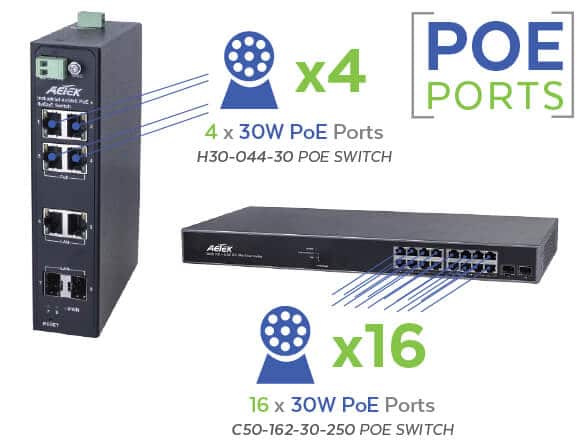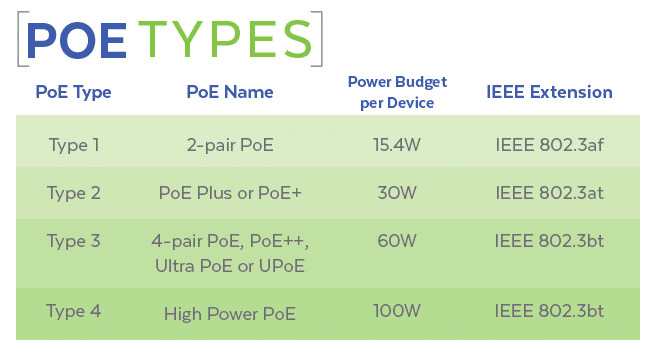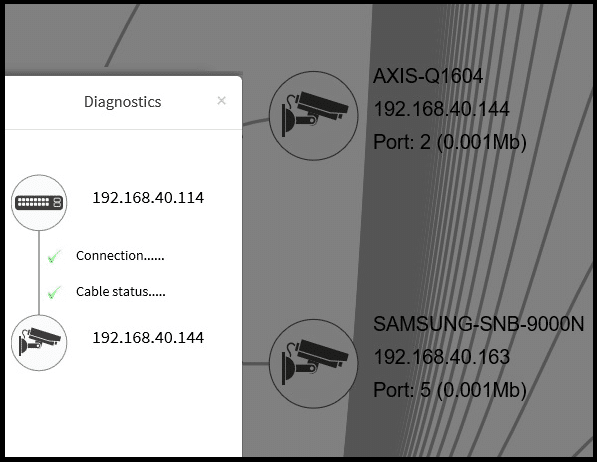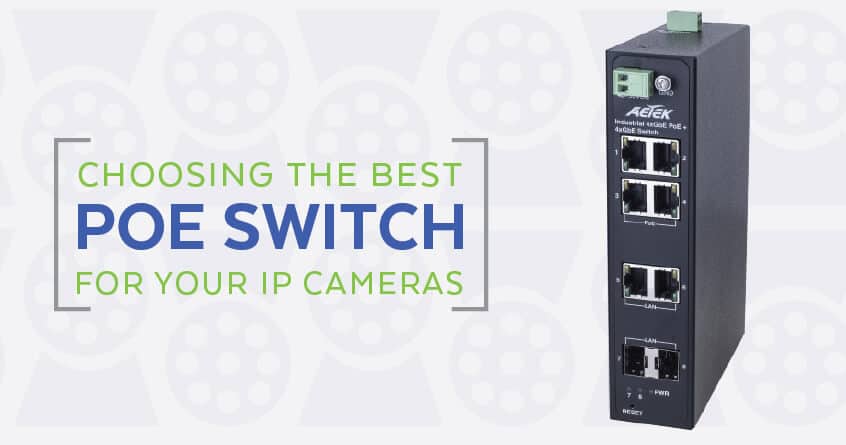IP cameras are in wide use for improving security through remote monitoring of public and private places and institutions. The “Power over Ethernet” (PoE) feature defined by the IEEE standards 802.3af, 802.3at and 802.3bt helps reduce wire clutter by powering the IP cameras from the Cat5 or Cat6 cables that already provide data traffic. When your installation has more than two IP cameras, it makes sense to use a PoE switch as the power sourcing equipment (PSE). In addition to being a PSE, many PoE switches come with extra features for network configuration and device management. It is important to carefully consider the basic and special features of a PoE switch for IP cameras so that you can select the best one.
Basic Considerations
Port Count
The most basic consideration in selecting a PoE switch for IP cameras is the number of IP cameras it needs to support; this number determines the port count on the PoE switch. You need to select a PoE switch that has enough ports to support not only the IP cameras you are connecting to the switch now but also any additional cameras you may connect to it in the future. PoE switches with as few as 4 and as many as 24 ports are available from AETEK USA.
 Power Capacity
Power Capacity
The next basic consideration for PoE switch for IP cameras is the output power at its ports. You need to be sure that each port can adequately meet the power requirements of the end device, or powered device (PD), connected to it. The power available at each port of a PSE of a specific PoE type is:
- PoE Type 1, aka 2-pair PoE: 15.4W (governing standard is IEEE 802.3af)
- PoE Type 2, PoE Plus or PoE+: 30.0W (IEEE 802.3at)
- PoE Type 3, aka 4-pair PoE, PoE++, and Ultra PoE or UPOE: 60.0W (IEEE 802.3bt)
- PoE Type 4, aka high power PoE: 100.0W (IEEE 802.3bt)
 Note that the power delivered to the PD is less than the power output of the PSE due to transmission loss. The power available to each IP camera for the various PoE types is:
Note that the power delivered to the PD is less than the power output of the PSE due to transmission loss. The power available to each IP camera for the various PoE types is:
- PoE Type 1: 12.95W
- PoE Type 2: 25.5W
- PoE Type 3: 51.0W
- PoE Type 4: 71.0W
Special Features of a PoE Switch for IP Cameras
Once you have ensured that the PoE switch has the right port count and power capacity for your needs, it is beneficial to consider its extra features. Some of these are:
- Dynamic Voltage Output,
- Energy Efficient Design,
- Data Speed,
- Embedded Device Management, and,
- Compliance with Standards.
Dynamic Voltage Output
Some IP cameras operate with 12V while others need 24V. If the voltage output of the PoE switch does not match the IP camera’s voltage rating, it can damage the switch or the camera or both, unless the switch is capable of adjusting its output to match the camera’s operating voltage. It is good to get a PoE switch for IP cameras that can automatically detect the PD’s voltage requirement and set the port’s output voltage to match it.
Energy Efficient Design
The power consumption of a PoE switch for IP cameras is a recurring operating expense that can add up to be significant dollars over time. Be sure to select a switch that complies with the IEEE 802.3az standard for energy-efficient design. Any price difference over a non-compliant switch will be quickly recouped through lower electricity bills.
Data Speed
A switch operating at a lower speed will slow down your network. To prevent this from happening, it is important for the PoE switch to operate at Gigabit speed even if the IP cameras operate at a lower data rate.
Embedded Device Management System (DMS)
PoE switches with embedded DMS are better than switches that require an external Network Management System (NMS) for managing devices. Here are the reasons why:
- There are no separate DMS licensing costs since it is embedded in switch software.
- The use of NMS requires additional hardware and special training for support staff.
- By virtue of being integrated with the switch software, embedded DMS is simpler and more intuitive to use than NMS.
- DMS can alert the operator in case of issues like cable faults in the network.
 The embedded DMS in switches has a simple user interface that provides device-level management, traffic monitoring, and power consumption reports.
The embedded DMS in switches has a simple user interface that provides device-level management, traffic monitoring, and power consumption reports.
Compliance with Standards
Even though there are non-standard implementations of PoE in the market, you are better off using switches that comply with IEEE standards. This will protect you from interoperability issues and also give you a future proof PoE switch for IP cameras.
Note that the special features listed above may make the PoE switch more expensive to buy but the additional cost is quickly recouped through lower operating expenses since they are easy to install, configure, and manage.
AETEK USA has both managed and non-managed PoE switches for IP cameras that suit various port count, power and device management requirements. Please contact us with any questions or to discuss your specific needs.

